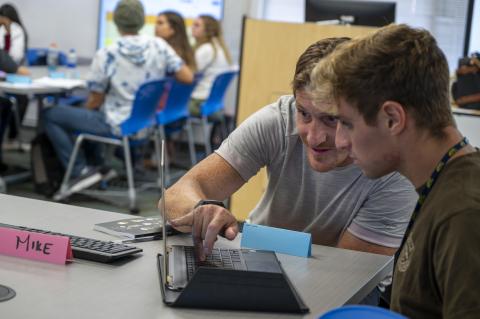Basic Lesson Planning
Giving a good lecture or lesson takes organization and planning (especially for novice teachers!). All lesson plans should consist of at least the following elements:
-
A list of required teaching materials (e.g. readings, media, slides, lab materials, handouts)
-
At least 1 learning objective that is specific to that day, directly related to one of the course outcomes, and that prepares students for the associated homework or assessment. See the section below on aligning objectives and activities.
-
A list of specific points that must be covered to achieve the day's learning objective.
-
A list of activities you will use during class, in order of delivery and with an approximation of how much time each will take (e.g. pairs/small groups, lecture, polls, demonstrations, students at the board).
-
Some way that you will gauge student understanding before the end of class.
-
Split up your available lecture/lesson time every 10-20 minutes with different types of activities or a different delivery format (e.g. lecture, media viewing, stretch break).
Lesson Planning Templates
Copy this Basic Lesson Plan Template to organize your lesson
Copy this Zoom Lesson Plan Template for Small Group Discussions in breakout rooms
Use Planning Tips for Live Board Work online to guide your Zoom sessions
Upside-down lesson plans for university teaching
A typical university lecture begins with... well, a lecture from the instructor that covers the main points of the day's topic. At some point(s) before the class ends, the instructor has the students do something to practice using the newly-explained knowledge. An upside-down lecture begins with the typical end. That is, it begins with students practicing the day's topic in some introductory way. This gives the students a concrete experience in which to situate the abstract content in the rest of the day's lecture. Bernice McCarthy calls this “Connecting” to the learners.
An upside-down lecture:
-
connects the students to the concept before any detailed information is presented.
-
uses a hands-on, interactive activity that makes the topic real and tangible.
-
uses as many of the 5 senses as possible.
-
solicits emotion and recognizes the emotions as valid, whether it's fear, discomfort, excitement, happiness, or curiosity.

Examples of beginning-of-lecture activities that connect students to the lesson
In the table below, note that the activity is not just a story, video, or diagram that you present and students receive in a passive way. It engages them and connects them to the content in a personal, experiential way that they share with you and/or with peers. By openly sharing with others at the beginning of the lesson, you discover the students’ level of understanding while acknowledging their capacity to contribute to the learning community. Then you can use the students' acknowledged responses to customize your lecture. For example, relate their responses to the abstract parts of the topic, such as jargon, descriptions, frameworks and examples.
| Reflective Opening Activities | Hands-on Opening Activities |
|---|---|
| Read or watch a real application/story about the topic. Have pairs of students briefly discuss an interesting question about it. | Give students a handout with a diagram, matrix, or other visual about the topic and ask them to fill out as much as they can in 1 minute. |
| As students arrive, have them write a on the board/chat to answer an open-ended question about the topic (they write it, not you). | Have a demonstration (or videos of demos) going as students arrive. Let early students try the demo in some way before settling down. |
| Ask a poll question about students' existing knowledge, opinion, or prediction about the topic. | Ask a few students to help you conduct a lab demonstration, role play an important event, or work through a problem on the board. |
| Put a problem on the board/screen and ask students how/where they would start solving the problem. | Ask students to think back to a real-life experience that exemplifies the day's topic. Engage them in the emotions and decisions of that memory through writing or drawing. |
Examples of Lesson Activities Aligned with Learning Objectives (for Section)
| Students will identify whether their question is a permutation or combination question. | Use Jigsaw technique: Students will be put into groups and solve one problem together (each group solving a different question). Then, the students will scramble so that each new group contains one person from each original group. Students will explain the problem and answer to their new group. |
| Students will analyze a given conditional into its component parts and identify those parts. | Use a think-pair-share exercise: Individually analyze a short passage, then compare notes with a peer. Debrief as a whole class about their conditionals by calling on a few groups. |
|
Students will describe and contrast at least 5 attributes of ecology and environmentalism from the readings. |
Use a collaborative online document: small groups of students analyze the readings by creating a venn diagram to compare attributes and determine whether the authors were ecologists or environmentalists. Debrief as a whole group by calling on a few group leaders to show their venn diagram and justify their determination of the author’s positions. |